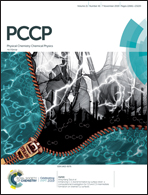Beyond molecular nitrogen: revelation of two ambient-pressure metastable single- and double-bonded nitrogen allotropes built from three-membered rings†
Abstract
In this study, we present a crystal structure prediction and characterization for two novel single- and double-bonded nitrogen allotropes (denoted as CubN and DobN) bearing three-membered nitrogen cycles. These materials are ambient-pressure metastable robust solids with strong cohesive energies. Due to the presence of strained nitrogen cycles, these allotropes are high-lying phases, which retain high energy densities at least up to 200 GPa, when CubN becomes lower in energy than ζ-N2. The studied allotropes are indirect wide-bandgap semiconductors. A detailed spectral characterization of these materials is also presented herein. Due to their extremely high heats of formation and crystal densities, CubN and DobN demonstrate excellent detonation properties that are comparable to those of previously reported phases (cg-N and TrigN). Propulsive properties (including specific impulse and characteristic velocity) of CubN and DobN as solid monopropellants were also estimated. Thus, if synthesized, the present nitrogen allotropes will have great potential for practical applications and achieving fundamental knowledge about nitrogen as a chemical element.



 Please wait while we load your content...
Please wait while we load your content...